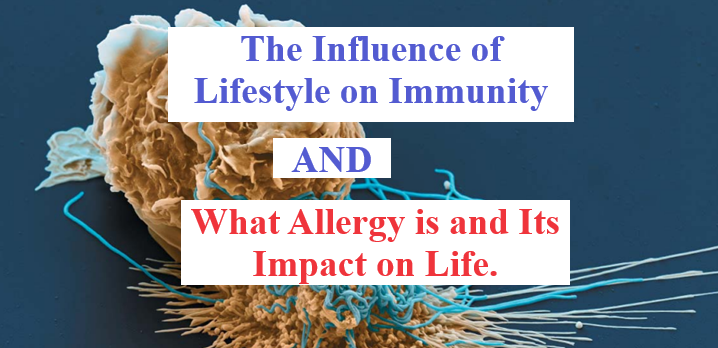
The Influence of Lifestyle on Immunity
- Protein-calorie malnutrition is the single greatest contributor to decreased resistance to infection worldwide.
- When inadequate amino acids are available to synthesize essential proteins, immune function is impaired.
- Deficits of certain nonprotein nutrients can also lower resistance to infection.
- Both stress and state of mind can affect resistance to infection and cancer.
The immune system can alter neural and endocrine function, and, in turn, neural and endocrine activity modifies immune function.
For example, Lymphoid tissue receives input from nerves, and immune cells have receptors for certain hormones.
Conversely, immune cells release cytokines that have important effects on the brain and endocrine system.
Moreover, lymphocytes secrete several hormones that are also produced by endocrine glands.
The multiple mind-body interactions that affect disease resistance are the subject of a field called psychoneuroimmunology.
Of the hormones associated with stress, the adrenal hormone cortisol has received the most attention due to its powerful suppressive activity on inflammation and acquired immunity.
Among other things, cortisol inhibits the production of inflammatory mediators, reduces capillary permeability in injured areas, and suppresses the growth and activity of certain types of leukocytes.
In this way, it acts as a sort of brake on the immune system.
During chronic stress or when cortisol is used to treat certain illnesses for long periods, it may cause immunosuppression.
This is a key link between stress and health.
Chronic stress may lead to a chronically increased concentration of cortisol in the blood that, by suppressing the body’s immune responses, lowers resistance to infection.
Another feature of a person’s lifestyle that appears to affect immune function is exercise.
The influence of physical exercise on the body’s resistance to infection and cancer has been debated for decades.
Evidence now indicates that the intensity, duration, regularity, and psychological stress of the exercise all have important influences, both positive and negative, on a variety of immune functions, such as the number of circulating NK cells.
Although evidence suggests that too much intense exercise can reduce immunity, most experts currently believe that moderate exercise and physical conditioning have net beneficial effects on the immune system and disease resistance.
Recent studies suggest that exercise may be particularly beneficial in helping to ward off the onset of breast cancer, one of the most common types of cancer in women.
What Allergy is and Its Impact on Life
An allergy (also known as hypersensitivity) is a condition in which immune responses to environmental antigens cause inflammation and damage to body cells.
Antigens that induce allergic reactions are called allergens.
Common examples of allergens include ragweed pollen and animal dander.
Most allergens themselves are relatively or completely harmless.
It is the immune responses to them that cause the damage.
In essence, then, allergy is immunity gone awry, for the response is of inappropriate strength and duration for the stimulus.
For any allergy to develop, a genetically predisposed person must first be exposed to the allergen a process called sensitization.
Subsequent exposures elicit the damaging immune responses we recognize as an allergy.
Hypersensitivities can be broadly classified according to the speed of the response.
Allergies that take up to several days to develop are considered delayed hypersensitivities.
The skin rash that appears after contact with poison ivy is an example.
More common are reactions considered immediate hypersensitivities, which can develop in minutes.
These allergies are also called IgE-mediated hypersensitivities because they involve IgE antibodies.
In immediate hypersensitivity, sensitization to the allergen leads to the production of specific antibodies and a clone of memory B cells.
In individuals who are genetically susceptible to allergies, antigens that elicit immediate hypersensitivity reactions stimulate the production of IgE antibodies.
Upon their release from plasma cells, these IgE molecules circulate throughout the body and become attached to mast cells in connective tissue.
When the same antigen enters the body at some future time and binds with IgE that is bound to mast cells, the mast cell is stimulated to secrete many inflammatory mediators, including histamine, that then initiate an inflammatory response.
The signs and symptoms of IgE-mediated hypersensitivity reflect both the effects of inflammatory mediators and the body site in which the binding of antigen to the IgE bound to a mast cell occurs.
When, for example, a previously sensitized person inhales ragweed pollen, the antigen combines with the variable region of IgE, and the constant region of IgE binds to mast cells in the airways.
The mast cells release their contents, which induce increased mucus secretion, increased blood flow, swelling of the epithelial lining, and contraction of the smooth muscle surrounding airways.
These effects produce congestion, runny nose, sneezing, and difficulty in breathing characteristic of hay fever.
Antihistamines are drugs taken by people to block the action of histamine that is released during allergic responses.
These drugs prevent histamine from binding to its receptor protein on its target cells, thereby preventing or relieving some of the symptoms of allergy.





